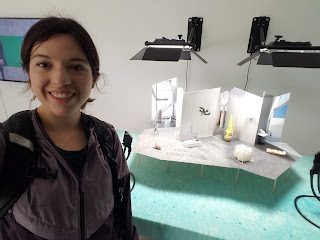Extra Credit Event: Weak Or No Signal
This quarter, I had the opportunity to attend the UCLA DESMA Master's of Fine Arts showcase for the graduating class of 2018. This was undoubtedly one of the more interesting events I have attended that relate to the DESMA field because it was visually interactive. If a picture is worth a thousand words, then an MFA project is worth a million because of the amount of effort put in. For this particular exhibit, it was evident how the projects utilized technology to their advantage.
One of the first pieces I saw was an electronic jacket. It could flash lights down the length of the arm and was wired extensively. This product proved a unique approach to wearable technology, as it introduced tech to an article of clothing as opposed to being a typical accessory add-on. This reminded me of the lecture by Waseda University professor, Machiko Kusahara, who shared that the future of robotics is shifting towards more people-relating robots. This MFA project proves the realization of such a possibility, bringing the robot to the very skin of a person. Perhaps the future of clothing will be technology itself and perhaps humans will desire to become more like robots themselves.
Another interesting robotics-based project is the one shown above, which I would refer to as a "Talon Clock" because at the ends of the long metal wires are sharp claws that appear to be those of an animal. The mechanization behind this display is found in the rotation of the arms, representing how work can be automated much more efficiently using robots, even if the task is not necessarily a practical one (Vesna). Mechanization can clearly be used by engineers and artists alike.
Finally, the most intriguing project at the MFA exhibit I encountered would be the one shown above. On a projection screen, a video of moving, lit-up, "sheets" intertwine with each other, reminding me of space. It was beautiful, bright, and seemingly holographic.
In Victoria Vesna's lecture on space and art, we learned that Obama had signed the NASA Authorization Act of 2010, beginning a new era of commercial space exploration and development. As a result, companies such as Virgin Galactic and SpaceX have begun research to make space travel possible for non-scientists. I found this MFA project to be a creative way to bring a space-like experience to earth, or even serve as a unique picture of what it might be like (or even feel like) to explore space more deeply.
Sources
 | ||
A Selfie with Home-like Artwork
|
One of the first pieces I saw was an electronic jacket. It could flash lights down the length of the arm and was wired extensively. This product proved a unique approach to wearable technology, as it introduced tech to an article of clothing as opposed to being a typical accessory add-on. This reminded me of the lecture by Waseda University professor, Machiko Kusahara, who shared that the future of robotics is shifting towards more people-relating robots. This MFA project proves the realization of such a possibility, bringing the robot to the very skin of a person. Perhaps the future of clothing will be technology itself and perhaps humans will desire to become more like robots themselves.
 |
| Talon Clock |
Another interesting robotics-based project is the one shown above, which I would refer to as a "Talon Clock" because at the ends of the long metal wires are sharp claws that appear to be those of an animal. The mechanization behind this display is found in the rotation of the arms, representing how work can be automated much more efficiently using robots, even if the task is not necessarily a practical one (Vesna). Mechanization can clearly be used by engineers and artists alike.
 |
| Moving Light Projection |
Finally, the most intriguing project at the MFA exhibit I encountered would be the one shown above. On a projection screen, a video of moving, lit-up, "sheets" intertwine with each other, reminding me of space. It was beautiful, bright, and seemingly holographic.
In Victoria Vesna's lecture on space and art, we learned that Obama had signed the NASA Authorization Act of 2010, beginning a new era of commercial space exploration and development. As a result, companies such as Virgin Galactic and SpaceX have begun research to make space travel possible for non-scientists. I found this MFA project to be a creative way to bring a space-like experience to earth, or even serve as a unique picture of what it might be like (or even feel like) to explore space more deeply.
Sources
“DMA 2018 MFA Thesis ExhibitionWeak Or No Signal.” Art & Education, 14 May 2018, www.artandeducation.net/announcements/158398/weak-or-no-signal-ucla-dma-2018-mfa-thesis-exhibition.
“MFA Thesis Exhibition.” UCLA Design Media Arts, www.dma.ucla.edu/exhibitions/mfa/2018/.
Vesna, Victoria. “Robotics + Art.” Lecture 1. <https://cole2.uconline.edu/courses/888567/pages/unit-3-view?module_item_id=16300798>.
Vesna, Victoria. “Space + Art.” Lecture 4. <https://cole2.uconline.edu/courses/888567/pages/unit-9-view?module_item_id=16300833>.
Kusahara, Machiko. “Professor Machiko Kusahara on Japanese Robotics.” Lecture. <https://cole2.uconline.edu/courses/888567/pages/unit-3-view?module_item_id=16300798>.
Vesna, Victoria. “Space + Art.” Lecture 4. <https://cole2.uconline.edu/courses/888567/pages/unit-9-view?module_item_id=16300833>.


Comments
Post a Comment